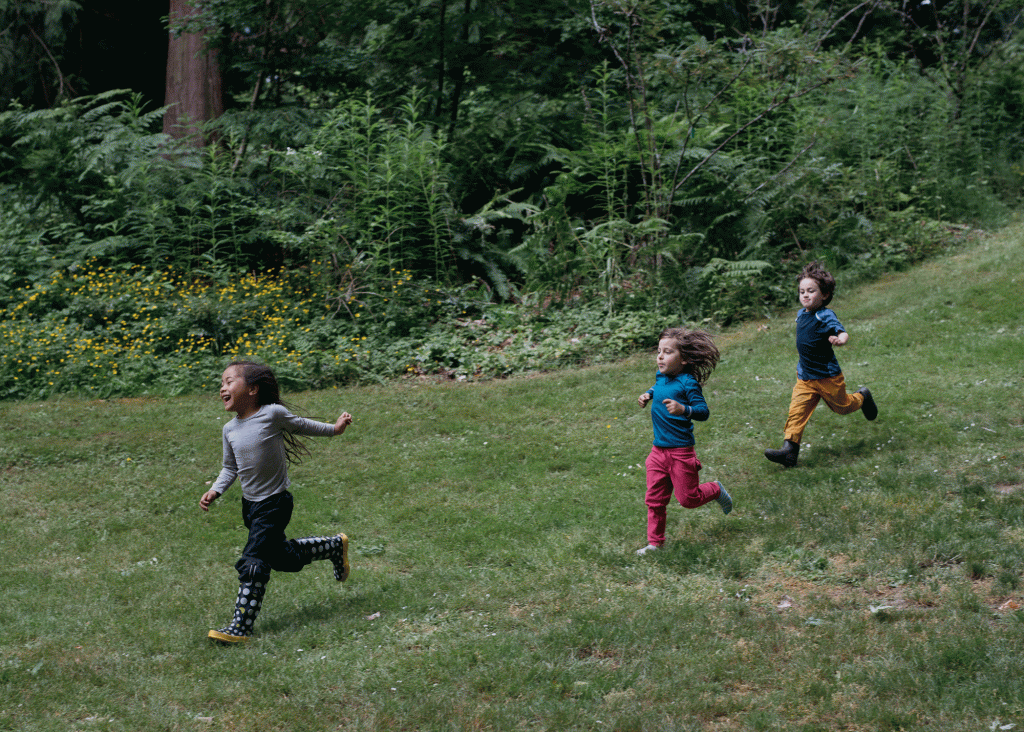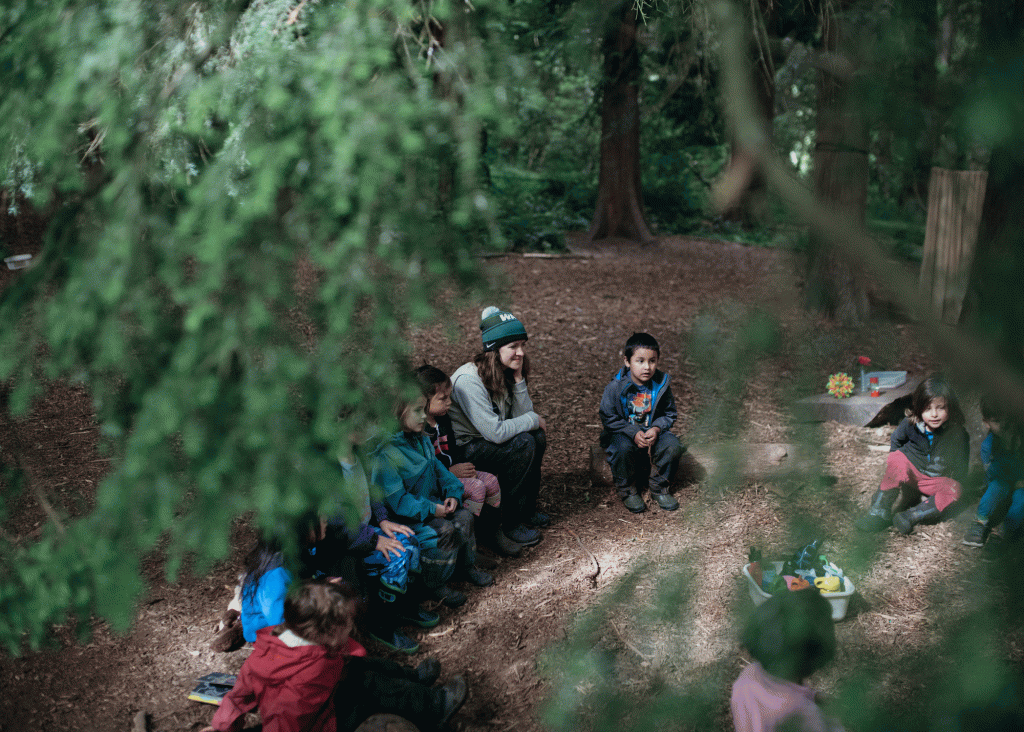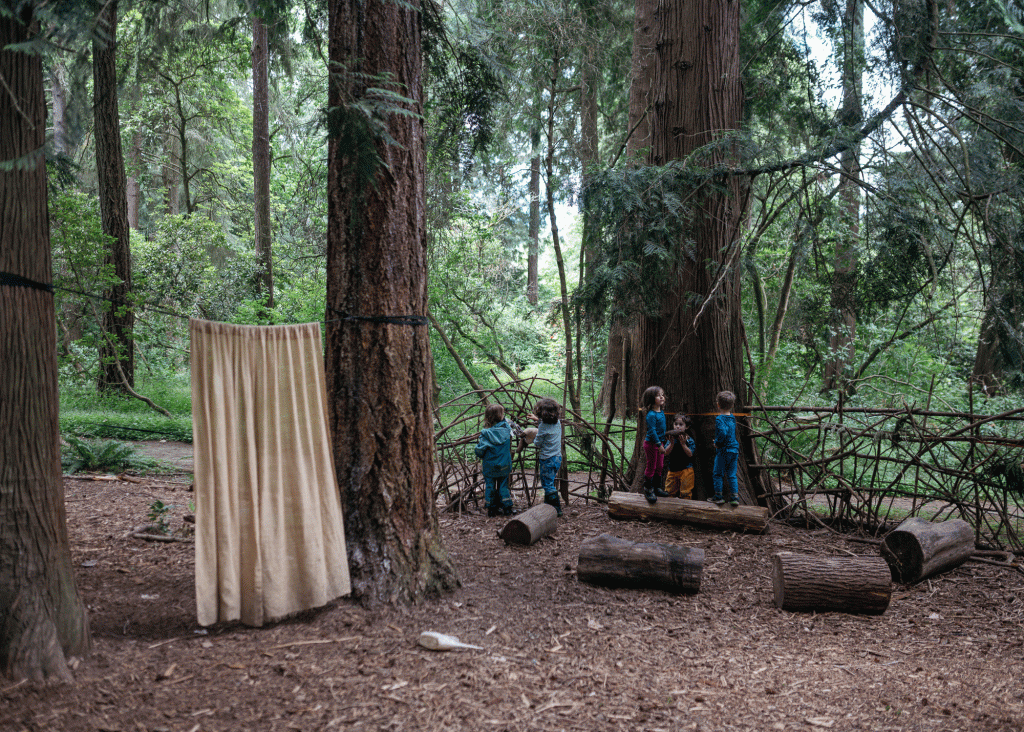A version of this story appeared in the fall 2019 issue of Uncommon Path.
On a rainy January day in Seattle, you’ll find most preschoolers tucked away in a heated classroom, dabbing at finger paints or molding clay. Not Rose, a 4-year-old who attends Fiddleheads Forest School. There, with temperatures hovering around 40 degrees Fahrenheit, Rose and her 13 classmates are huddled together under a tarp hung among trees, learning to make cedar tea.
On nicer days, Rose, whose name has been changed for privacy, typically spends sunshine-splashed hours wielding a magnifying glass in search of pleasingly grotesque species of insects, from which her teacher pivots into lessons about habitats and life cycles. She uses binoculars to spot nesting ospreys or plays pretend in a mud kitchen, then eats her lunch picnic-style in a meadow.
At this school—as with a growing number of similar programs nationwide—the outdoors isn’t just for recess anymore. In fact, the outdoors is her school. The idea is simple: Use the woods as a backdrop for a solid, hands-on education and a sorely needed way to help a new generation connect with the real world.

For the students at Fiddleheads, green grass isn’t reserved for recess.
A growing number of preschool programs offer this experience across the United States: In 2017, there were more than 250 nature-based preschools and forest kindergartens in 43 states, according to Emilian Geczi, former director of the Natural Start Alliance, a nonprofit focused on connecting young children to the environment. Two years later, the number of schools has reached 400. While outdoor preschools are on the rise, there’s still work to be done to determine if these programs represent a notable shift in American early-childhood education. Among the key challenges: improving access and affordability and advancing research to understand the benefits the schools provide.
Outdoor preschools have roots that reach back to 1950s Scandinavia, but the movement has gained momentum and urgency in the past decade as the digital world has mushroomed. It’s an antidote to what author Richard Louv famously labeled “nature-deficit disorder” in his 2005 best-seller Last Child in the Woods. In 2006, Louv cofounded the Children & Nature Network, which aims to make nature part of every child’s daily existence on an international scale.
Now, that momentum is being borne out in the research. Studies show that when students engage with the ever-changing natural world in their learning environment, they demonstrate better concentration, less stress, higher rates of physical activity, increased engagement and improved self-discipline. In February 2019, the journal Frontiers in Psychology reviewed 95 studies that examined how exposure to nature affects learning. The conclusion? Natural settings facilitate a calm, cooperative social landscape where students engaged with the nature around them.

Fresh air substitutes for a whiteboard at Fiddleheads.
In Europe, where the idea has deep roots, students at Danish day-care centers average two hours outdoors each day in all seasons, and 75% join in on at least one weekly outing to a forest, beach or marsh. Swedish kids frolic outside even in the dead of winter and take a daily nap outside as weather allows. And Germany boasts more than 1,500 forest kindergartens.
Back in Seattle, an environmental educator named Sarah Heller was working at the Washington Park Arboretum in 2010 when she teamed up with former Montessori teacher Kit Harrington to start Fiddleheads. “We had schools come on field trips, and we offered summer programs,” Heller says. “But I wanted to find ways to connect kids and families with this beautiful treasure in Seattle that not many people know about.”
“We started out with blocks, puzzles and other materials,” says Harrington. “But we realized over time that the classroom itself was the ultimate material.”
The 230-acre arboretum, associated with the University of Washington Botanic Gardens, on the shores of Lake Washington, was an ideal location. Heller and Harrington began with one outdoor space in the gardens for a classroom that would welcome 12 kids ranging in age from 3 to 5. “We started out with blocks, puzzles and other materials,” says Harrington, “but we realized over time that the classroom itself was the ultimate material.” The first spring, a barred owl nested in a classroom. Students learned to mimic the calls of the four owlets before they fledged.
The program’s ethos immediately resonated with Seattle families, who recalled backpacking trips, fort building and languid summer days spent splashing in outdoor pools from their own childhoods. Nine years later, the school has two bustling classrooms, where 14 students and two teachers immerse themselves in the rhythms of the natural world on a daily basis.

Getting close to nature is an everyday thing for these preschoolers.
These opportunities come with a price. Tuition for the four-hour, five-day option over 10 months is $8,300, averaging about $200 a week for the half-day program. Financial aid is offered, but for some families attending a half-day program such as Fiddleheads creates insurmountable obstacles, like finding transportation during work hours and affording supplementary childcare.
One problem is that current childcare-center licensing standards are primarily designed for indoor settings. Without a license, outdoor preschools cannot offer full-day options or tap into state subsidies that assist low-income families with childcare costs. States are only now starting to address the issue. In 2017, Washington State launched a four-year pilot project to study a dozen of the state’s 40-plus outdoor preschool programs and consider licensing standards. For nature-based programs to reach their full potential, they’ll also need plenty of instructors who know how to teach in an outdoor environment. Teacher-training courses are starting to fill these gaps. In July, the Natural Start Alliance issued guidelines for training, helping connect teachers to environmental-education certificate programs popping up across the country.
As these changes take place and outdoor preschools become more mainstream, the hope is that a broader population will be served. However, there are still questions of scale, access and student diversity. The tally of 400 outdoor preschools looks impressive until you consider that there are 120,000 childcare centers across the country, according to Child Care Aware, a nonprofit that connects parents with providers. In addition, Natural Start Alliance’s 2017 national survey reveals a student body that is not representative of the U.S. population: 83% of the students in these nature-based settings are white; just 3% are Black, 7% Hispanic. Students with special needs and dual-language learners are also significantly underrepresented.

The Fiddleheads classroom: An improvised curtain works for musical and theatrical performances and playing; the logs are used for story time.
Educators are trying to change that. One example is the University of Minnesota’s Shirley G. Moore Lab School, where students typically spend a third of their time outside (and the eight-week summer program operates fully outdoors). Of the 102 students at the licensed facility, 13% have special needs and 28% are children of color. While financial assistance helps families with the $6,130 full tuition, the program’s secret for building diversity goes beyond just dollars. “Accessibility is very important, and so is having staff [composed of ] people of color,” says director Sheila Williams Ridge. “People see their families and their values reflected in the space.”
But for the families whose kids participate in outdoor education, their school is more than just part of a burgeoning international trend. It’s simpler than that. It’s a peaceful place for kids to develop curiosity and admiration for the natural world at a young age, with the hope that they’ll carry on that appreciation to future generations.
As Louv notes: “Early exposure builds a stronger bond to nature and makes a lasting imprint—those of us who had that connection as kids have a responsibility to pass it along.”
Honor Roll
A collection of outdoor-oriented schools for students of all ages.
Preschool (Ages 3 to 6)
South Mountain Nature School (SMNS), Maplewood, New Jersey
Full-body rainsuits are included in the tuition of SMNS—which has a complete commitment to an all-outdoor, all-the-time immersion in nature and meets five mornings a week in the 2,100-acre Olmsted Brothers–designed South Mountain Reservation. southmountainnatureschool.com
Chicago Botanic Garden Nature Preschool, Chicago, Illinois
At the state-of-the-art Regenstein Learning Campus, kids ages 3 to 5 spend their time learning from resident horticulturists, going on hikes around the impeccable grounds and even keeping a journal by drawing or dictating to an adult. chicagobotanic.org
Mountaintop Waldorf School, Saugerties, New York
Instead of stressing academics, Moun-taintop emphasizes the rhythm of the seasons: a paper-lantern festival as winter approaches and a regatta—featuring little handmade boats—come summer. Plus, kids are out in the elements every day, sleet or shine. mountaintopschool.com
Elementary/Middle School
The Garden School, Marietta, Georgia
Children learn woodworking, gardening, foraging, citizen science, ecology and knitting. There’s also a learning farm that contains goats, donkeys and chickens—and the curriculum places a huge emphasis on limiting kids’ media exposure. thegardenmarietta.org
Teton Science Schools, Jackson, Wyoming, and Victor, Idaho
TSS runs a full-time prekindergarten-through-12th-grade school that emphasizes the importance of place. (Lucky for them, that means field experiences in Yellowstone and Grand Teton National Parks.) tetonscience.org
Juniper Hill School, Alna, Maine
The founder of this little gem in mid-coast Maine has taken some 42 acres of woods, fields and marshes—plus a 1762 farm-house owned by her parents—and turned it into a forest school. These days, Nature (ages 3 to 4), Seeds (3 to 5), Roots (5 to 6), Sprouts/Branches (6 to 8) and Branches/Leaves (8 to 10) use the main house, three yurts and more as classrooms while learning respect for and knowledge of indigenous skills. juniperhillschool.org
Sierra Expeditionary Learning School, Truckee, California
Every October, the entire student body and staff of SELS climb a nearby peak. And at the end of the year, each eighth-grader ceremonially presents a kindergartner with a rock from a local stream, passing on an intention for that child’s school career. The rock stays with the child—as does the school’s emphasis on community, collaboration and public speaking. truckeecharterschool.org
High School
Colorado Rocky Mountain School, Carbondale, Colorado
A mix of boarding and day students spend time in a traditional classroom (Advanced Placement courses, Socratic seminars and the like), but extracurricular classes include climbing, cycling, horsemanship and backcountry skiing in the mountains near Aspen. The Crystal River Kayak Races—the oldest high school kayaking competition in the country—runs right by campus. crms.org
The Outdoor Academy, Pisgah Forest, North Carolina
Sophomores spend about a quarter of their semester on wilderness trips in the southern Appalachians and weekends learning adventure skills to pull it off. The rest of the time? They might use solar ovens to learn about parabolic curves, try paddling maneuvers to figure out what vector angles are and debate global food economics. enf.org/outdoor-academy
Midland School, Los Olivos, California
At this small boarding prep school on the border of Los Padres National Forest, students are cooks, carpenters, librarians and custodians. More than half the food served there (including grass-fed beef) is raised on their ranch or grown in a 10-acre organic garden, and orienteering, nature writing and field science are included. midland-school.org
Sun Valley Community School (SVCS), Sun Valley, Idaho
Even kindergartners at SVCS take outdoor trips, but it’s the older kids that really get to explore: Freshmen take a weeklong whitewater trip on the Main Salmon River, and juniors bring Edward Abbey and Thoreau with them on 48-hour solos in southern Utah. Bonus: The school’s Outdoor Leadership Academy preps students to lead trips professionally. communityschool.org
Photography by Grant Hindsley
